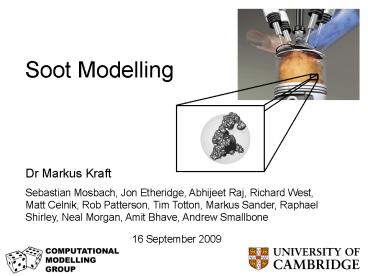Soot Modelling - PowerPoint PPT Presentation
1 / 37
Title: Soot Modelling
1
Soot Modelling
Dr Markus Kraft Sebastian Mosbach, Jon Etheridge,
Abhijeet Raj, Richard West, Matt Celnik, Rob
Patterson, Tim Totton, Markus Sander, Raphael
Shirley, Neal Morgan, Amit Bhave, Andrew Smallbone
16 September 2009
2
Soot Formation
Burner
Flame
Carbon Addition Reactions Oxidation by O2 and
OH,
Condensation of PAHs
Particle Inception by PAHs
Coalescense
Aggregation
3
Part 1
- Quantum chemistry
- Kinetic Monte Carlo
- Basin hopping
- Population balance
4
Molecular soot structure
- Nanoparticles (3 nm 2 µm)
- Primary particles occur due to dimerisation of
PAH molecules - What is the critical PAH size to form a dimer in
flame conditions? - How mobile are PAH molecules within a particle?
- How does morphology change and how does this
affect the rates of sintering between primary
particles?
5
Soot model hierarchy
Quantum Chemistry (DFT)
Full representation of molecules Determine
kinetic parameters
PAH Aromatic Site Model (ARS)
Functional site description PAH reactions as
jump processes
Kinetic Monte-Carlo (PAH KMC)
Single planar PAH simulations Used to generate
internal particle structure
Population Balance (PAH-PP)
Particle ensemble modelling Particles described
by PAH-PP Model Inception, growth and coagulation
6
Oxidation processes in PAHs
Investigated reactions
PAH Polyaromatic hydrocarbons
Oxidation process
Decomposition process
7
Using structural information
8
Oxidation rates of different site types
Zigzag next to zigzag (zz)
Eact156 kJ/mole
Zigzag next to free edge (zf)
Eact161 kJ/mole
Armchair next to free edge (af)
Eact173 kJ/mole
Units k in cm3/(moles), T in K
9
PAH reactions (selection)
Free-edge growth
Free-edge desorption
5-member ring addition
5-member ring desorption
Armchair growth
5- to 6-member ring
Frenklach, Wang, Violi
10
PAH KMC growth simulation
Growth of a PAH molecule kinetic Monte Carlo
(KMC) simulation
11
PAH growth mechanism
12
PAH growth rates - sensitivity
P. Weilmünster, A. Keller, and K. H. Homann.
Combust. Flame, 1166283, 1999.
13
PAH-PP model State Space
Structure of a particle P
n number of primary particles p of particle P
C Matrix containing the sphericity of the
neighbouring primaries
Each primary particle pi is composed of m PAHs
14
PAH-PP model Data structure
Contains C2,5
Contains C5,6
15
PAH mass spectra
J. Happold, H.-H. Grotheer, and M. Aigner. Rapid
Commun. Mass Sp., 2112471254, 2007.
C2H4 - O2 flame, Pressure 120 mbar, C/O 1,
Cold gas velocity 54 cm/sec
Monomers
Monomers
Dimers
Dimers
Experimental
Computed
16
Coagulation efficiency
17
PAH coagulation efficiency
18
HRTEM images of soot
- Some evidence for different soot structures based
on different fuels - Top graphitic
- Bottom amorphous
Pictures from Uitz, Cracknell, Jansma and
Makkee, Impact of diesel fuel composition on
soot oxidation Characteristics, SAE 2009-01-0286
19
Investigating structure
- How do PAH molecules form clusters?
- How do these clusters grow?
- Driven by intermolecular potentials
Alston Misquitta, Aron Cohen,Dwaipayan
Chakrabarti, Mark Miller, David Wales
20
Comparison of potentials
- Poor agreement between L-J potential and
SAPT(DFT) results - Good agreement with W99 potential
Graphite (Gr)
Slipped Parellel (SP)
Crossed (X)
21
Basin hopping
- Finds stable molecular clusters by searching for
minima - Based on potential energy landscape
- Uses Monte-Carlo criterion when jumping between
minima
22
Global minimum clusters
10 Coronene molecules
2 Coronene molecules
5 Coronenes molecules
E -94.90 kJ/mol
E -394.35 kJ/mol
E -926.42 kJ/mol
23
Experimental comparison
Experimental HR-TEM images of an aggregate
sampled from a diesel engine. Indicated are
length scales of structures within a primary
particle (from Mosbach et al., 2009, Combustion
and Flame).
A TEM-style projection of a computed cluster of
50 coronene molecules
24
Cluster Density
- Need to define cluster volume
- Used scaled van der Waals radii
- Define Volume in terms of scaling factor, a
- Determine critical a to determine density
25
Cluster density
- Volume varies non-linearly with a
- Choose critical a at minimum of dV/da (acrit
1.7) - Corresponds to point where all intermolecular
space is covered by overlapping spheres.
26
Varying density in our models
- For acrit 1.7,
- coronene ? 1.1 g/cm3, pyrene ? 1.0 g/cm3
- Standard soot density in models 1.8 g/cm3
- Density has been shown to be an important
parameter
27
Part 2
- Soot model validation in SRM
- Converted SI HCCI engine
- SRM SI
- Soot in DISI
28
Engine model SRM
29
Soot in engines!
- HCCI, n-heptane
- Compression ratio 12
- Equivalence ratio 1.93
- Throttled, 20 EGR
30
Aggregate size distributions (I)
Experiment
Simulation
31
Partially stratified HCCI engine
32
SI Model
- The turbulent flame speed is used to calculate
the new flame radius. - When the calculated volume is greater than the
particles volume a new particle is added to the
entrained zone.
- The chemistry within each particle is calculated
with a detailed mechanism containing 157 species
and 1552 reactions.
- The model contains three zones.
- Particles move from entrained to burned zone once
heat release rate goes above then drops below a
certain value.
BURNED
- Mixing occurs within each zone but not between
zones.
ENTRAINED
UNBURNED
33
GDI SI Research Engine
- In collaboration with Professor Richard
Stone from Oxford University.
34
DISI Engine
- Late injection produces stratified mixture.
- Fuel rich regions close to spark gap.
Image from www.engineforall.com
35
Soot in DISI Engine
? 1.0 EOI -50 CAD ATDC Spark -30 CAD ATDC
36
Soot in DISI Engine
32.6 CAD ATDC
12.6 CAD ATDC
2.6 CAD ATDC
37
Thank you! Please visit our website
http//como.cheng.cam.ac.uk

